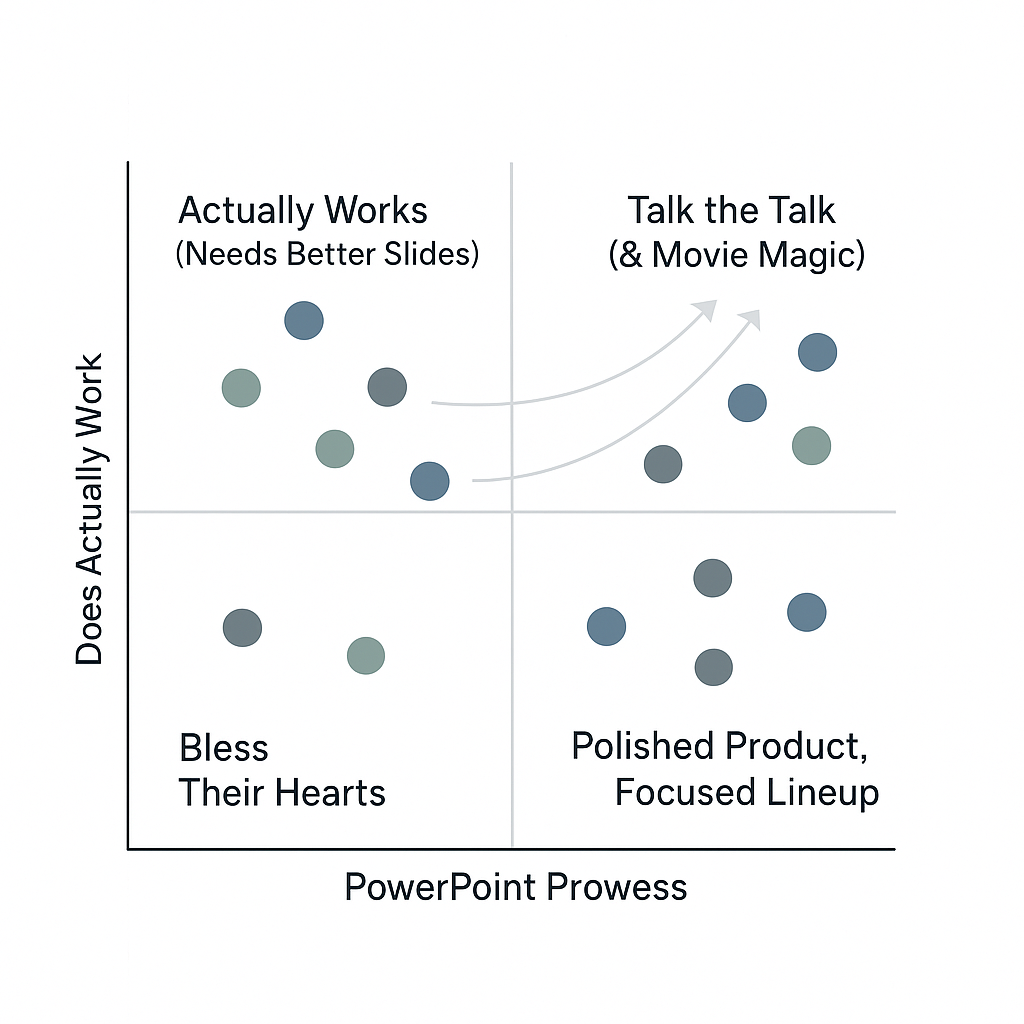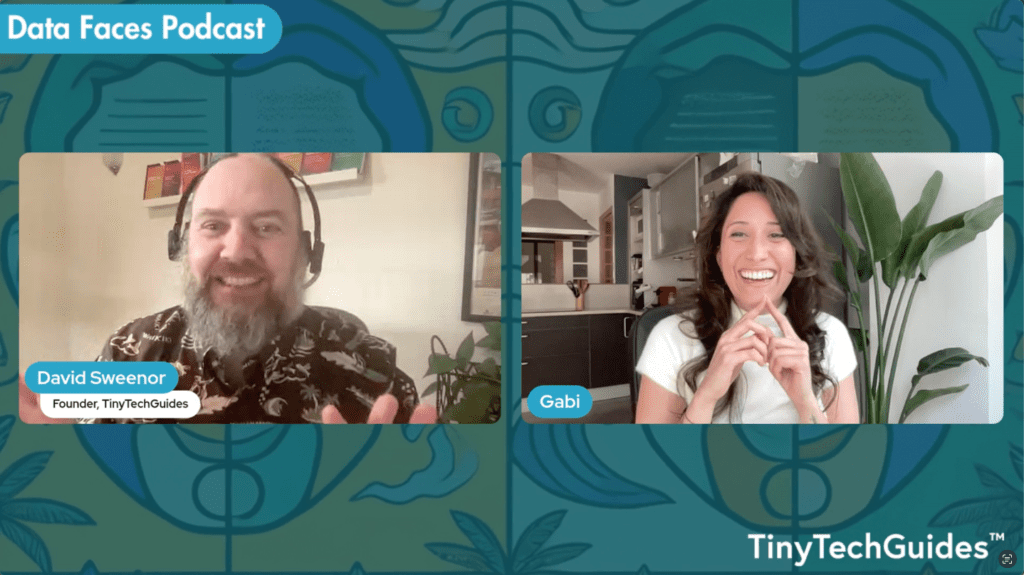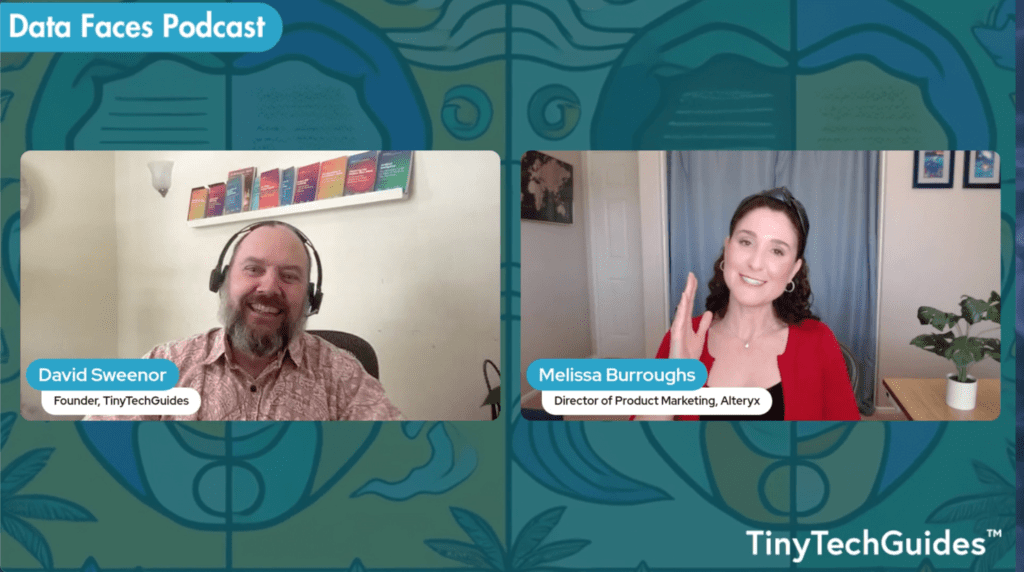Decoding the Dots: What the Gartner MQ for DSML Really Means for PMMs

So, the dots have danced. Again.
Well, folks, it’s here, after sitting and waiting for the most inopportune time, it finally happened. The publication of the annual DSML Magic Quadrant. Cue the collective, synchronized sigh of marketing teams everywhere as the overwrought interpretations and frantic narrative re-spinning commence! Once again, we get our front-row seat to Gartner’s “market dynamics”—a euphemism for the familiar culling of smaller players (pour one out for Anaconda, KNIME, and Posit) and a hearty cheer for sheer scale, while newcomers like Snowflake get to find out just how crowded the Visionary middle is.
And isn’t it just perennially fascinating how those tech behemoths, with their sprawling empires of acquisitions, consistently land in that coveted Leaders box? It really makes you ponder whether we’re seeing seamlessly integrated DSML super-suites or just cleverly marketed portfolios still awkwardly trying to locate the ‘integrate’ button. This brings us to the question we all whisper while redrafting internal FAQs for the fifth time: did the products genuinely evolve, or was it mainly the PowerPoints, perceptions, nice dinners, and painstaking placement justifications that did the heavy lifting this year?
The “process”: a PMM’s passion play in a prologue and five agonizing acts
Ah, the “process”—that annual command performance. It’s less methodology, more theatre of the absurd, and we PMMs are the reluctant stars.
- Prologue: The questionnaire quagmire. It begins: the dreaded RFP arrives. Hundreds of Byzantine questions demanding a herculean effort to answer. Does anyone read the resulting tome, or is it just consulting business fuel and keyword-searched into a score? The resource drain is legendary, the PITA-factor off the charts.
- Act 1: The briefing charade. Survived the RFP? Congrats. Now, in your allotted hour, pitch your “full-stack integration” and “baked-in governance” (this year’s DSML magic words). Dazzle ’em, especially if you’re competing with Big Tech’s “movie magic” demos that make the Modern Prometheus products look like soulmates.
- Act 2: The analyst mind-meld. The real show: trying to divine if the analyst is absorbing your “long-term platform bets” or just pondering their lunch order. Are those nods insightful or merely polite? The poker face is stoic.
- Act 3: The dot reveal & the scramble. Voila! The dots appear. Cue the internal scramble to interpret, position, and prep for executive Q&A on why your dot isn’t leading the conga line (unless it is, then brace for “why aren’t we further ahead?”).
- Act 4: The internal “translation” tour. Now, explain your dot’s precise landing spot by aligning it with Gartner’s “five themes”—usually last year’s ideas with fresh lipstick. Your job: make it sound intentional, strategic, and not at all like you just got lucky (or unlucky).
- Act 5: The “privilege” of quoting & the disclaimer dance. The grand finale! Try to use your hard-won dot in marketing. Submit. Wait for approval. Rewrite. Pepper with “In our opinion…” until your killer soundbite is a neutered whimper. And for this compliance nightmare? You pay handsomely. Bravo.
From the trenches: what these DSML dot shifts actually tell us (if anything)
So, the MQ has published – often announced with an internal urgency worthy of Paul Revere shouting, “The dots have landed! The dots have landed!” Beyond the executive summary spin and the all-hands alerts, what can we PMMs really glean from this annual DSML shuffle? Let’s look past the official pronouncements.
The “leaders” mosh pit. Up in that top-right corner, Gartner often calls the offerings “roughly comparable.” Translation: they’re all blending together. Your impossible PMM job? Find that one microscopic differentiator they haven’t yet homogenized and cling to it for dear life.
“Vision” overboard! Everyone’s apparently a visionary this year, rushing rightward on the chart, chests puffed with “Multimodal GenAI.” So, PMMs, how are you spinning your text-to-SQL feature into a “foundational step towards multimodal interaction”? Gartner loves a good “long-term platform bet” story (hello, Databricks, practically floating off the right edge of the chart on their vision cloud!), but who’s actually executing these grand schemes reliably at scale? That’s a different story.
The point solution purge & the suite life. Remember when being “Python-friendly” or great at notebooks was special? Quaint. The memo now screams “control planes” and sprawling “full suites.” Your elegant point solution? Suddenly, it’s a “niche tool.” Get ready to explain to execs why your “ingredient” is vital, even as they eye Snowflake’s “Visionary” debut and ask why you haven’t built an entire AI theme park.
The execution shell game. What moves a dot up that Y-axis? Apparently, solid enterprise wins, referenceable customers, and healthy margins now trump open-source buzz (ask H2O.ai or Cloudera). IBM and DataRobot inch up. And SAS’s slip into Visionary-land reminds us that even heavy R&D doesn’t impress if go-to-market traction looks wobbly to the scorekeepers. It’s a tough game.
Why we still play this expensive game of musical chairs (and pay for the privilege)
So, why do we pour endless PMM hours, budget, and sanity into this annual MQ circus? What compels our otherwise rational companies to engage?
First, Sales needs their “holy scripture” – provided Gartner and internal legal ever approves a slide they can actually use. Then there are the execs, many still convinced this report dictates all major deals. You’ve heard their hopeful refrains: “Landing in Leaders could be a $20M revenue swing!” And you’ve seen the reality: crickets. But executive hope (and perhaps bonus structures) springs eternal.
Fear is a motivator too. When new players like Snowflake just materialize mid-Visionary, and others like Anaconda or KNIME get delisted, the FOMO – or FOGD (Fear Of Getting Delisted) – gets very real. So we chase Gartner’s “credit rating for ambition and delivery,” paying a premium for the privilege of announcing our (heavily disclaimered) “rating.” That’s budget which could fund actual innovation, or at least a cathartic team offsite to vent about this very process. But hey, priorities.
Your jaded PMM’s DSML dot survival kit: 2025 edition (now with legal defense strategies!)
Since we’re all buckled in for this annual ride, how do we PMMs keep our sanity (mostly) from unraveling? Here’s your updated survival kit.
- Deconstruct their “themes” before they deconstruct you. First job post-MQ: Grab Gartner’s latest “key themes” (Full-stack! Cloud-native! Responsible AI baked-in! Whatever today’s buzzword salad is) and create your internal PMM-to-Reality translation guide. What’s the most plausible, legally defensible spin you can put on each for your product?
- Manage the narrative – aggressively (and compliantly). This is PMM poetry time. Gartner dings your “Responsible AI”? Your line: “Our phased approach prioritizes robust, customer-validated governance features, slated for H2.” Dot drifted right but not up (all vision, less execution)? You’re “boldly defining the future, with execution rapidly aligning!” Up but not right? “Laser-focused on proven, enterprise-grade value today!” Spin it to win it (or at least survive the internal review).
- Counter the “full suite” mantra (if you’re not one). If you’re a focused solution, arm sales with 3 sharp questions proving your faster ROI against the lumbering “full suite” behemoths still trying to integrate their last five acquisitions.
- For SAS-like situations (strong vision, execution slips). If Gartner loves your vision but dings your execution (hello, SAS-style quadrant shift!), immediately double down on visible customer proof points and near-term roadmap delivery. “Demonstrable progress” is your new best friend.
- Focus on real wins (your sanity corner). Create a “Things That Actually Matter” folder: real customer successes, revenue impact, positive usage data. Open it when legal butchers your MQ snippet or an exec asks about that mythical $20M revenue bump. It’s your reality anchor.
So long, and thanks for all the dots (and the invoices)
And just like that, another Magic Quadrant cycle is in the books. The market has been “clarified” (wink, nudge), the dots exhaustively dotted, the PowerPoints powerpointed into submission. We’ve all earned our PMM battle scars for another year.
Will next year’s “weighted themes” be a stunning departure or just a clever remix? Will the content compliance dance get any less torturous? Don’t bet on it – just make sure the budget for reprint fees is approved early.
But hey, we survived. Now, it’s back to the actual job: understanding customers, building real narratives, and marketing DSML products that people genuinely need. That work continues long after these reports are lining recycling bins or, more aptly, propping up a wobbly monitor somewhere.
Until next year, fellow dot-watchers. May your briefing decks be concise, your analysts attentive, and your legal team lenient. Keep fighting the good fight.
Grab a copy of the dots at any of our fine friends at:
- https://www.ibm.com/new/announcements/ibm-named-a-leader-in-the-2025-gartner-magic-quadrant-for-data-science-and-machine-learning-platforms
- https://www.databricks.com/resources/analyst-research/gartner-mq-data-science-and-machine-learning
- https://domino.ai/resources/gartner-magic-quadrant-data-science-machine-learning-2025
- https://cloud.google.com/blog/products/ai-machine-learning/gartner-2025-magic-quadrant-for-data-science-and-ml-platforms
About David Sweenor
David Sweenor is an AI, Generative AI, and Product Marketing Expert. He brings this expertise to the forefront as founder of TinyTechGuides and host of the Data Faces podcast. A recognized top 25 analytics thought leader and international speaker, David specializes in practical business applications of artificial intelligence and advanced analytics.
Books
- Artificial Intelligence: An Executive Guide to Make AI Work for Your Business
- Generative AI Business Applications: An Executive Guide with Real-Life Examples and Case Studies
- The Generative AI Practitioner’s Guide: How to Apply LLM Patterns for Enterprise Applications
- The CIO’s Guide to Adopting Generative AI: Five Keys to Success
- Modern B2B Marketing: A Practitioner’s Guide to Marketing Excellence
- The PMM’s Prompt Playbook: Mastering Generative AI for B2B Marketing Success
With over 25 years of hands-on experience implementing AI and analytics solutions, David has supported organizations including Alation, Alteryx, TIBCO, SAS, IBM, Dell, and Quest. His work spans marketing leadership, analytics implementation, and specialized expertise in AI, machine learning, data science, IoT, and business intelligence.
David holds several patents and consistently delivers insights that bridge technical capabilities with business value.Follow David on Twitter @DavidSweenor and connect with him on LinkedIn.


